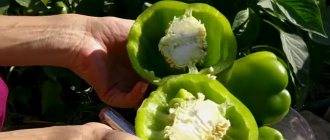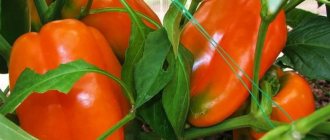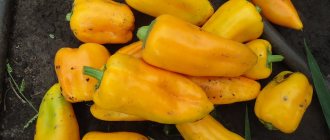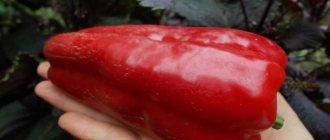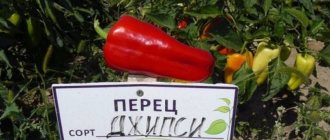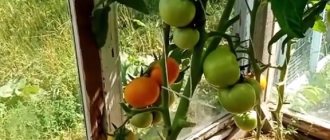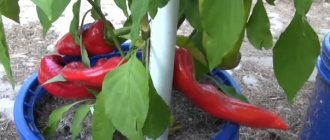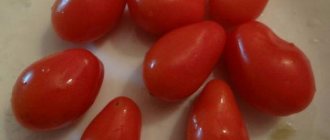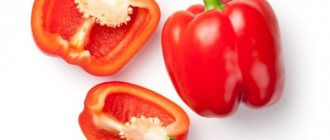Pepper, like tomatoes, is a frequent “guest” in domestic garden plots, since it is distinguished not only by its excellent taste characteristics (coupled with a large amount of vitamins and minerals) and high yield, but also by its ease of cultivation/care. One of the most unusual early varieties of pepper is considered to be Big Mama. We bring to your attention a detailed description of the variety: description, yield, as well as reviews from gardeners about the characteristics of the crop (photo materials are attached).
Features of cultivation and care
Big Mama is suitable for growing in any climatic conditions.
Can grow both in a greenhouse and in open ground. Like most varieties of pepper, the Big Mama variety is grown using the traditional method - seedlings. Since the variety ripens early, sowing of seeds begins quite early - in early March. Advice. Seeds of the Big Mama variety, according to reviews from gardeners, are characterized by fast, but not very high germination - only about 80%, so additional processing will not hurt them. Soak the seeds in a weak manganese solution for 20 minutes, and then (if desired) in aloe juice. This will help increase the germination of seeds and nourish them with strength.
When growing seedlings, young shoots will need feeding: a comprehensive option is quite suitable. If the seeds are sown in early March, they will need full light (12-hour days), which can be provided with the help of a special lamp. When the height of the young shoots reaches 20 cm, you can stop the additional lighting and place the containers with the shoots in a bright place.
Seedlings are planted on the site 75 days after sowing the seeds according to a 50x35 cm pattern. Approximate planting period: late May - early June. It all depends on the climatic characteristics of the region in which the site for growing the crop is located. Big Mama peppers love light, loose soil, especially loam.
Attention! Under no circumstances should you plant pepper in an area where its predecessors were nightshades, as they deplete the soil, absorbing almost all the microelements that pepper needs. Since the variety is large-fruited, the plant will need additional support throughout the growing season: be sure to tie up the pepper bushes
In addition, to obtain a rich harvest of fruits that have reached the maximum possible size, add a complex of nutrients to the soil in the beds (you can use ready-made complexes, or natural organic matter). Do not forget that fertilizing should be applied to the soil at least 3 times: almost immediately after planting, during the period of active growth and during the process of fruit ripening.
Since the variety is large-fruited, the plant will need additional support throughout the growing season: be sure to tie up the pepper bushes. In addition, to obtain a rich harvest of fruits that have reached the maximum possible size, add a complex of nutrients to the soil in the beds (you can use ready-made complexes, or natural organic matter). Do not forget that fertilizing should be applied to the soil at least 3 times: almost immediately after planting, during the period of active growth and during the process of fruit ripening.
Watering the plant should be moderate (it is advisable to use warm water), and the soil should be loose and weed-free. If you follow all the above agricultural techniques for growing peppers, by August you can harvest delicious ripe fruits.
Our acquaintance with the Big Mama pepper is coming to an end. As you can see, it is an almost ideal “candidate” for growing in open ground and should definitely end up on your site. Good luck!
Pepper cultivation
They grow Big Mama through seedlings. This method is most optimal in a temperate climate zone.
The first stage of growing pepper consists of preparing the seeds and proper care of the seedlings, the second is the further care of the plants transplanted to a permanent place in the ground.
Seed selection and preparation
Big Mama seeds can be purchased at a seed store or market.
Before planting, seeds must be prepared:
- Disinfect to destroy possible fungi and bacteria. To do this, use a weak (pale pink) solution of potassium permanganate, in which the grains are soaked for half an hour. After disinfection, they must be washed with water.
- Stimulate growth, since Big Mom’s germination rate is low. To do this, the seeds are soaked for several hours in a growth stimulant (for example, in Epin, Novosil, Zircon or Phytospectrum). You can use natural stimulants - aloe juice or ash.
- Germinate. The seeds are wrapped in a damp and warm napkin and left for several days until the first roots appear from the grains.
After the first tiny roots appear, the seeds are planted as seedlings in small pots or cups.
You need to plant seeds for seedlings at the end of February if you plan to grow them in a greenhouse, or at the beginning of March if the crop will grow in open ground.
Preparing the soil for seedlings
Pepper loves light, porous and loose soil. These parameters are even more preferable for this crop than fertility.
Composition of soil for seedlings:
- sand;
- peat;
- Earth;
- humus.
All parts must be mixed evenly in equal quantities 1:1:1:1. Instead of peat or sand, you can use wood ash. Alternatively, you can use a ready-made soil mixture purchased at a flower shop.
As containers for growing, you can use plastic glasses or small pots, the size of which is 10x10. Containers must contain holes to drain excess moisture, and drainage (small pebbles, polystyrene foam, stone chips) must be placed at the bottom before filling the soil.
Features of caring for seedlings
After planting the seeds in separate pots, they need to be properly cared for:
- Creating a warm and humid microclimate. To do this, containers with seedlings need to be covered with plastic film or a bag.
- Regular moderate watering. It is necessary to avoid both stagnation of water and drying out of the soil, watering the seedlings as the top layer dries. Typically watering is required 2-3 times a week. The water should be settled and warm.
- Bright lighting. Since peppers are planted early, in late February - early March, there is still too little natural light, so the seedlings are placed under lamps, providing them with at least 12 hours of lighting. Additional light can be removed at the end of March - by this time there is already enough natural light, and therefore the pots are simply transferred to the windowsills on the sunny side.
- Fertilizer. During the entire seedling period, young plants need to be fed with complex mineral fertilizers. offers fertilizers of its own production, Aelita-Vegetable, ideal for Big Mom.
- Temperature conditions. During the day, temperatures should be within +23. +25°C, and at night - +18°C.
Transplanting seedlings into the ground
Seedlings become ready for transplanting into the ground to a permanent place from the moment they grow to 20 cm in height and the plants form 6 to 10 strong, well-developed leaves. This usually happens about 75 days after planting the seeds.
Planting in the ground can be done no earlier than the end of May, since for pepper it is important that the soil warms up to +14°C. But since the weather at this time may still be unstable in some regions, it is recommended to cover young plants in the garden with film, insulating them. Pepper should be planted according to a 35x50 cm pattern, and this crop does not like going deep into the ground, and therefore planting should be shallow
She needs breathable and loose soil, ideally loamy
Pepper needs to be planted according to a 35x50 cm pattern, and this crop does not like going deep into the ground, and therefore planting should be shallow. She needs breathable and loose soil, ideally loamy.
It is better to prepare the holes in advance by digging them about 20–35 cm deep and spilling them with water. It’s good if the ground for pepper has been fertilized with organic matter, ash and superphosphates since the fall. If not, then place a layer of humus at the bottom of the holes.
You need to transfer the sprouts along with a lump of earth into wet holes using a transshipment method. Dig in some soil, water, then loosen the soil.
Growing and caring for Big Mama peppers
This variety is not picky regarding climatic conditions and can be grown in places with any weather conditions. This pepper can thrive both in a greenhouse and in open ground. “Big Mama” seeds should be prepared very early, in early March, since rapid ripening is supported by their careful processing.
Important! “Big Mom” seeds are distinguished by their fairly rapid germination, as many gardeners claim.
However, their height is not very large, it is only 80%, for this reason additional processing actions in relation to the seeds will not interfere, but will only help stimulate good growth. To do this, you need to place the seeds in an infusion of potassium permanganate for about 15-20 minutes, after which you can soak them in aloe juice, but this procedure is not necessary, although no less useful. Such manipulations will enrich your seeds with additional strength and speed up the appearance of the first shoots.
During the process of growing seedlings, your pepper will need constant feeding, but it is worth using a comprehensive option. For example, if you plan to plant your seeds in early March, then it will be extremely necessary for them to be provided with adequate light supply. That is, your seeds should be kept in a well-lit room for 12 hours a day. For this purpose, you can purchase specialized lamps that simulate sunlight.
However, as soon as the height of the first shoots reaches 20 cm, it is necessary to immediately stop providing the plant with light. At this point, the sprouts already need natural light, so move them out of the room to where they can feed on it.
“Big Mama” peppers are planted in open ground 75 days after planting. Approximately this should happen at the end of May or beginning of June. This aspect directly depends on the climatic conditions of your region. This variety of pepper needs loose soil; you should give special preference to loam.
On a note! Under no circumstances should you plant Big Mama peppers in areas where you previously grew nightshades, as these plants significantly deplete the soil, sucking most of the minerals out of it. Many microelements contained in the soil are necessary for “Big Mama” for successful growth. Therefore, either use another area for planting, or pre-treat the soil, filling it with the missing microelements.
It is worth recalling that the fruits of the Big Mama pepper are quite large, therefore, as soon as the plant size reaches half a meter or more, this species will seriously need additional supports and garters. In addition, add nutrients to the soil to get a rich harvest. This is especially true for those fruits that are visually larger than all the others.
It is also necessary to systematically feed the plant. This should be done three times: almost immediately after planting, during the period of active plant growth, and also during the period of dynamic fruit ripening. To water the Big Mama pepper, use warm water, it should be moderate. Make sure that the soil under the plant remains loose and free of weeds.
It should be noted that additional feeding of the plant with mineral fertilizers is important, since this type of pepper has large fruits. Professional gardeners claim that the best solution for this would be fertilizer complexes specially created for this purpose. They will provide your pepper with all the nutrients it needs.
Fact! If you planted your pepper in early March, then the plant needs almost constant sunlight, since all the processes that stimulate the growth and rapid maturation of your pepper use it for subsequent successful growth.
There is also a hybrid variety of this pepper, which is called “Big Mama F1”. It is somewhat different from the usual "Big Mama" look as it is of South Korean origin. It is grown mainly in agro-industrial areas. Its taste is in stark contrast to the regular Big Mama. Big Mama F1 is often spicy, with just a hint of sweetness. Therefore, before purchasing, carefully check whether you are buying the right pepper seeds.
Growing seedlings
The seedling method speeds up adaptation to adverse weather conditions. It is prepared 50 days before planting the seeds in the ground.
Planting pepper
Plant peppers in any convenient container. These can be cut plastic bottles, thick bags and even eggshells. An excellent container for Big Daddy peppers is seedling boxes with drainage holes. They are made of wood or plastic. In the store it is not difficult to choose the size of the box that is suitable for a specific window sill. It is convenient to care for the sprouts in the box; all the seedlings are nearby. If necessary, all peppers are transferred to another place. The recommended height of the box is at least 8 cm.
The distance between seedlings should be at least 7 cm. Small grooves 1 cm deep are made in the soil using a pencil. 2-3 disinfected seeds are placed in each hole, sprinkled with earth on top and watered with warm water. To create a greenhouse effect, seedlings are covered with polyethylene or thin glass. Remove the shelter after 2 weeks, when the first shoots appear.
Seedling care
Sweet pepper seedlings need warmth and sunlight, so the best place for them is a windowsill. Care consists of timely watering and fertilizers. Water the seedlings once every five days; it is recommended to use warm water from the filter.
Cold tap water increases the risk of dangerous germs growing. Peppers are fertilized 15 days after planting. The first feeding is liquid organic matter, for example, bird droppings or mullein. The next time the seedlings are fed is another two weeks later. To accelerate growth, stimulants are used - the drugs “Kornevin” or “Heteroauxin”.
Growing conditions and benefits
Big Boy is a large-fruited pepper with fleshy fruits that contain a huge amount of vitamins and microelements. Bell peppers are deservedly included in therapeutic diets for exhaustion, recovery from serious illnesses, anemia, tuberculosis and diseases of the hematopoietic system.
It has long been firmly established in the diet of not only residents of the middle zone, but also the northern regions. Eating lettuce peppers, especially fresh, prevents the occurrence of vitamin deficiency and other diseases associated with a lack of vitamins. Hence the increased interest in new varieties released on the domestic market.
Choosing the Big Boy variety for growing bell peppers is a smart step, if only because it is a low-growing, determinate-type plant that has excellent fruit set ability and high resistance to weather conditions and major types of pests. Like any sweet pepper, it prefers heat and moisture when grown and reacts negatively to their deficiency.
But due to its short stature, it spends less time forcing stems and leaves, and produces fruit faster. On average, on loam or sandy soil, with a minimum of required heat and well-drained soil, you can grow up to 8 kg of yield with fruits measuring 160-200 g with a thick wall filled with pulp and juice.
If you provide qualified care - water often, but not abundantly, feed and harden seedlings planted from high-quality seed material, then the harvest can be harvested slightly larger, but the fruits will reach up to 300 g. It is believed that there are more vitamins in fruits of technical ripeness, only that plucked from a bush. Those peppers that are stored for a long time still contain more vitamins than the famous black currants and citrus fruits of unknown freshness that are brought from abroad.
The Big Boy variety is positioned by the manufacturer not only as having beneficial properties, but also as an excellent keeping quality variety that can be preserved for a long time.
Note. Picked in a state of technical ripeness, the Big Boy variety is able to ripen, acquire a red color and ripe properties, and at the same time maintain a 100% attractive presentation. .
Medium ripening varieties
Medium-ripening varieties are no less popular among gardeners. Suitable for fresh consumption, canning, pickling and freezing.
Belozerka
Belozerka variety with red and yellow fruits
Belozerka
- Hybrid variety of medium fruit ripening.
- It is characterized by high productivity, resistance to pests and viral diseases.
- The fruits are medium-sized, weighing between 70-100 g.
- Thick-skinned vegetables with a wall equal to 0.7 mm.
- Green fruits appear first. Then their color changes to yellow, and at the ripe stage the vegetables become deep red.
- The good taste of the fruit, juicy and aromatic pulp, and long shelf life have made the variety universally popular.
Description:
- The height of the bush varies from 40 to 70 cm
- Friendly ripening of fruits
- Cone-shaped peppers weigh on average 80 g, wall thickness 7 mm
- Good transportability of fruits
- Recommended for growing in open ground
- Universal variety
ox ear
ox ear
ox ear
- Mid-season variety of sweet pepper.
- Technical maturity of the fruit occurs on days 97-99, and 125 days pass from sowing the seeds to harvesting.
- High-yielding variety Ox's ear. Up to 3 kg of fruits are collected from 1 m2.
- The plant is resistant to viral mosaic.
Characteristics:
- Bush height – 60-65 cm
- The length of the cone-shaped peppers is 10 cm, the thickness of the pulp is 0.8 mm
- Fruit weight is about 150 g
- Has good transportability
- Can be grown in a greenhouse, open ground, under film
- Resistant to viral diseases.
- Can be eaten fresh, cooked, canned.
Recommendations for growing the Big Mama variety
To obtain a good harvest, sweet peppers in most regions of Russia are grown through seedlings. They start with preparing seeds, soil mixture, and pots for seedlings.
Growing sweet pepper seedlings
Sowing dates are determined taking into account the climate of the region and plant growing conditions. Usually, the seeds of the variety are sown in February, so that at the end of May or beginning of June, seedlings can be placed in a greenhouse or in beds.
The seeds must be disinfected (using a pink solution of potassium permanganate) and soaked in a growth stimulator.
ON A NOTE! Instead of potassium permanganate, you can use a solution of boric acid (soak for two hours) or hydrogen peroxide (5-7 minutes)
It is important not to overcook the seeds. . Purchased growth stimulants (Phytospectrum, Epin and others) can be replaced with infusion of ash, aloe juice solution
After this, the seeds are soaked and then sown in pots. Pepper does not tolerate picking very well, and to avoid unnecessary stress, it is best to immediately sow it in separate containers. When sowing peppers in February, lighting is required to provide the seedlings with 10-12 hours of daylight.
Purchased growth stimulants (Phytospectrum, Epin and others) can be replaced with an infusion of ash or a solution of aloe juice. After this, the seeds are soaked and then sown in pots. Pepper does not tolerate picking very well, and to avoid unnecessary stress, it is best to immediately sow it in separate containers. When sowing peppers in February, lighting is required to provide the seedlings with 10-12 hours of daylight.
Pots with seedlings are placed in sunny places, ideally on south-facing window sills. The temperature should be in the range of +23°...+25° C, at night - up to +18° C. Water the plants with warm water (tap water must be left to settle). After watering, the soil is loosened, providing the root system with good access to oxygen. To strengthen seedlings and increase their immunity to diseases, they can be sprayed with simple herbal infusions - calendula, garlic, marigold.
For fertilizing (it will be enough to fertilize the plants twice), use a complex fertilizer (Kemira, Aelita vegetable), diluted mullein and poultry droppings are also suitable.
What problems can a gardener have when growing seedlings?
- With excessive watering, peppers can be affected by blackleg. The plant stalk in the lower part is depleted, the bush withers and lies down. It’s easy to avoid this - control watering and prevent the soil from becoming waterlogged. You can sprinkle calcined river sand onto the surface of the soil in a pot.
- Slow seedling growth, weak plants. Peppers urgently need nitrogen fertilizing, but here too it is very important to follow the norm!
Big Mama seedlings ready for planting should have 6-10 well-developed leaves, the plant height should be up to 15 cm.
You can plant sweet peppers when the soil warms up to +14°...+16° C. In many regions, cold snaps are likely at the end of May or beginning of June, so it is recommended to cover the seedlings on the beds with non-woven material.
Agricultural technology
It is recommended to grow seedlings even in the south, otherwise the harvest can only be expected in the fall.
Growing seedlings
- The sowing time depends on the period of planting in the ground or greenhouse. 70-90-day-old seedlings are planted in a permanent place. On average, sowing time: half of February - early March. If you plan to plant pepper in a greenhouse, sow the seeds earlier, in open ground - later.
- Success depends on the quality of seeds and plant care. Before sowing, you need to calibrate the seeds. Then carry out the treatment (disinfect, pickle) - soak for 20 minutes. in a light pink solution of potassium permanganate and rinse under running water. Also, for better germination, seeds are soaked in any growth stimulant (Epin, Zircon, Novosil, Gumate) for several hours (2-4 hours) and sown in nutrient soil or peat tablets.
- The base must be nutritious and disinfected. The seeds are planted in containers and then planted, in other words, immediately into 300-350 ml cups. The seeding depth is 1-1.5 cm. The tank is covered with film and placed in a warm place. Shoots appear on 5-10 Monday. It is noted that the seeds of the Big Mama variety produce good, friendly shoots.
- As soon as the first shoots appear, they are provided with long daylight conditions (12-4 hours). For this purpose, the seedlings are illuminated with fluorescent or LED lamps (phytolamps). In the first 4-6 days there is light around the clock. Additional illumination 12 hours in advance is continued until the plants have two true leaves; after a while the duration is reduced. If you observe the seedlings, you will see that in the evening the leaves close together when light is no longer needed. In another hour, the seedlings will get stronger and reach 20 cm in height, they are transferred to the windowsill, and the artificial lighting is stopped.
- In addition to light, seedlings need constant warmth and even watering. You can't overdry the soil, but overwatering is also harmful. The soil must be moist. The higher the temperature, the more moisture is required. Water with warm water under the root.
- Picking is done when the plant has 2 true leaves. Peppers do not tolerate picking well (as a result, many gardeners plant them one at a time in tablets or small cups, and then transfer them to a larger container.
- Seedlings are fed several times. Forward at the stage of two true leaves, before picking, the second time - after 10-14 days and the third time - a week before planting. If the seeds were planted in special soil, then the first fertilizing is not carried out. A solution of urea and potassium humate is used. You can use ready-made fields) for seedlings.
- 4 weeks before planting, seedlings begin to be calcined to reduce stress. The first bud is removed.
Care
Watering
Big Mama bell peppers are drought tolerant. It is better to plant seedlings in rainy weather, otherwise the plants will not take root.
After planting, the plant is watered 2 times a day, morning and evening. On hot sunny days, you should not water: the rays passing through drops of water burn the leaves.
During fruiting, the vegetable requires special care. If you do not give it enough water, the fruits will lose their presentation, dry out and become small.
You should also not flood the plant with water: moisture attracts slugs.
Top dressing
Feeding is needed starting from the seedling period, when the first 2 leaves have already appeared on the plant. The soil is fertilized with a urea solution. It will require 5 liters of water, 0.5 tsp. urea and 2.5 ml sodium.
Plants need regular fertilization
The next feeding is carried out on the 10th day after the first, when 5 leaves have already appeared on the bushes. For feeding, dissolve 0.5 tsp in water. urea and 1 tsp. potassium monophosphate.
You can also use microfertilizers:
- "Ideal". Fertilizer has a good effect on the growth of seedlings and promotes rapid adaptation after transplantation. To fertilize a plant, take 10 ml of the drug at the root and dissolve it in 1 liter of water.
- "Aquadon-micro". This drug significantly increases fruit yield. It is most often used for foliar feeding. For the solution, take 100 ml of the drug and dilute it in 10 liters of water.
- "Orton-Fe". This product increases the crop’s resistance to various diseases. It also speeds up all metabolic processes. For spraying use 5 g of the drug and 5 liters of water.
All these microfertilizers are used strictly according to the instructions so as not to harm the crop. In spring, phosphorus fertilizers are applied to feed the vegetable. They will need 30-40 g per 1 square. m.
Potassium fertilizers are applied with the same calculation. These feedings have a good effect on the growth and development of the root system of bell peppers.
For faster growth, nitrogen fertilizers are used. They need 20-30 g per 1 square. m. They are used in most cases during the flowering period.
To increase yield, pollinating insects are attracted. To do this, the bushes are sprayed with a solution of 100 g of sugar and 2 g of boric acid. The mixture is diluted in 1 liter of water. When the period of fruit ripening begins, ash is added to the soil (2 tbsp per 1 sq. m).
Reviews
Most reviews about the Big Mama variety are positive . People note its good yield, unpretentiousness, early ripening, excellent taste and attractive bright orange color.
Olga, Kaluga : “I really liked the variety, I’ve been growing it for two years now. I planted it in a garden bed, not in a greenhouse, and at the end of July the first orange fruits appeared. All other peppers ripened a little later, around mid-August. Advantages: unpretentious, does not require special care. It grew in rather poor soil, but the harvest was good.”
Oleg, Krasnoyarsk : “Orange peppers were grown for the first time, previously only red ones. We bought Big Mom seeds because we liked the description on the package. The reviews are also good. They planted it in a greenhouse. There were a lot of fruits, large, cube-shaped. Very sweet and juicy. I'm pleased with the variety. I paid a little more attention to it because it is new to me. The fruits are great for stuffing.”
Growing in open ground and tips on agricultural technology
Peppers can be planted both in greenhouses and in open ground. For this variety, the second option is best, because otherwise it may grow too tall in height and it will be inconvenient to monitor and care for the bush. It is best to plant seedlings in a permanent place at the age of 75 days.
Beginning gardeners will be interested in the fact that peppers of this variety are strictly forbidden to be planted in beds after plants of the nightshade family.
It is best if the predecessors for it are, for example, cabbage or legumes.
It is important to know: this time depends on the weather conditions of the region where you live. In most cases this occurs in May, but in areas with lower temperatures they begin to do this only at the beginning of the first month of summer. . It is also important to know that due to the fact that this variety is large-fruited, it needs to be fed additionally.
Of course, professionals say that it is best to choose complex fertilizers for this.
It is also important to know that due to the fact that this variety is large-fruited, it needs to be fed additionally. Of course, professionals say that it is best to choose complex fertilizers for this.
This should be done more than three times in one season. Pepper ripening occurs in August and continues until September.
Ripening dates and characteristics of fruits
The average fruit ripening period is from 94 to 106 days.
Fact: The vegetative cycle depends on the time of sowing. If you plant the seeds late, already in the spring, the bush will not produce a harvest as early as stated by the manufacturer. The bush begins to bear fruit abundantly after a short, beautiful flowering. More than a dozen fruits appear on one bush. It is imperative to trim the lower leaves so that they do not “draw” nutrients.
Peppers are considered biologically mature when they acquire a dark cherry hue. You can pick the fruits and send them for technical ripening or storage when the pepper turns purple.
From one square meter of plantings during the entire fruiting period you can remove from 6 to 8 kilograms of fruit. They are cone-shaped and of medium thickness. The wall is 4-5 cm, the weight of one pepper is 120 g.
Characteristics of Big Mama pepper
As is customary for gardeners, they begin to plant seedlings several months before the summer season. The time for planting each type is individual, for example, cabbage is planted in mid-February, and chrysanthemums are usually not earlier than April.
Similarly, like cabbage, “Big Mama” peppers are planted in mid-to-late February, however, the pepper needs to create the most favorable conditions for subsequent good fruiting
First of all, it is important to provide the pepper with as much light as possible, this will help speed up the appearance of the first shoots. For this reason, many gardeners believe that it is best to plant peppers in March, when there will be enough sunlight for favorable pepper growth, and there will be no need to create artificial lighting
However, this species belongs to those varieties that ripen and grow early. Therefore, experienced gardeners say that February is not the best time to plant Big Mama peppers. It is necessary to plant this species, preferably at the end of January, since the harvest will then appear much faster. And this aspect is decisive for many gardeners.
Gardeners claim that by allowing Big Mama peppers to grow on their plots, they end up with fairly large, bright orange, rectangular fruits. They are smooth to the touch and have no prominent ribs. Their weight is up to 200 g. The ripening period of “Big Mama” is two to three months, so after planting very soon you will be able to serve delicious peppers on your table as a component for a salad or a whole fruit stuffed with various fillings.
Fact. If you grow Big Mama peppers in greenhouses, the bushes on which the fruits appear can reach a height of a meter.
Gardeners quite often praise not only the size of the Big Mama pepper, but also its taste. This variety tastes very sweet and quite juicy. Gardeners often use this species for various purposes. They claim that it is universal and can be suitable not only as a culinary ingredient, but also for subsequent preservation.
Thus, the main advantages of Big Mama pepper include the following:
- excellent taste and tender pulp;
- high ripening speed;
- high productivity;
- large fruits;
- The plant is unpretentious to the conditions of maintenance and care.
Popular hybrid varieties for greenhouses
Hybrid varieties are created by crossing two common varieties. The variety’s status as a hybrid is indicated by the designation “F1” on the seed package. Hybrids differ significantly from regular peppers. They are more productive, have better appearance and taste. In addition, hybrids have larger fruit sizes and more compact bushes. But such good characteristics come at a price - they require better care.
Atlant F1
This is perhaps the most popular greenhouse hybrid variety. Considering that its ripening requires about 120 days, it can be classified as an early ripening hybrid. This hybrid is distinguished by its yield - up to 20 kg/m2.
Due to the fact that the height of an adult plant will not exceed 80 cm, it can also be grown in low film greenhouses. Atlant F1 pepper has an elongated cone shape with a glossy sheen. The average fruit weight is 190 grams. When mature, it is bright red in color. The walls are about 4-5 mm thick.
This pepper has an excellent taste, it is juicy and aromatic. It can be used for twisting. Antant F1 is resistant to many diseases and is undemanding in care.
Pinocchio F1
This early-ripening hybrid is capable of producing a harvest within 90 days. This sweet pepper has spreading bushes up to 1 meter in height. Considering that the bushes are semi-determinate, they need support or a garter. The elongated cone-shaped fruits of this hybrid have an interesting gradient color from dark green to red. The maximum weight of pepper will not exceed 120 grams, the wall thickness is 5 mm.
The pulp has good taste, it is juicy and aromatic. The hybrid is universal in its purpose. It can be used fresh, in home cooking and canning with equal success. It does not lose freshness for a long time and is immune to tobacco mosaic and blossom end rot. If care standards are followed, the yield will be up to 10 kg per square meter.
Star of the East chocolate F1
Hybrid variety of early fruit ripening. The bushes of the plant are powerful and branched, their height does not exceed 70 cm. Approximately 100 days after germination, its large, cylinder-like fruits begin to ripen. The weight of the fruit ranges from 260 to 350 grams, and the walls are 10 mm thick. This hybrid stands out from others due to the unusual dark brown color of the fruit.
The hybrid tastes good, it has sweet and juicy pulp. Its disease resistance and excellent shelf life are striking. In addition, the harvest will be up to 10 kg per square meter.
Latino F1
This variety is an early hybrid and begins to ripen after 100 days. Its tall bushes are compact in size. Ripe peppers have a bright red color, weigh 200 grams and have a wall thickness of 10 mm.
The fruits have excellent taste characteristics, they are tender and juicy. The yield per square meter is impressive - you can harvest up to 14 kg.
Negotiant F1
An early ripening hybrid variety for greenhouse conditions. About 100 days will pass from germination to the beginning of ripening. This plant is difficult to classify as compact. In addition to having many leaves, they can grow up to 1 meter in height. To prevent the plant from breaking under its own weight, it should be tied up. The fruits of this hybrid variety are shaped like a cone-prism and weigh up to 200 grams. In the ripening phase, they turn red with green inclusions.
Peppers have aromatic, sweet and juicy flesh. Due to this, they are ideal not only for fresh consumption, but also for twisting. The hybrid has good resistance to tobacco mosaic and verticillium. The yield will be up to 8 kg/m2.
Read also How to take aloe with honey for the stomach
Disease prevention and pest control
In a greenhouse, even the most disease-resistant varieties of sweet peppers can be affected by various infections. It is difficult to treat diseases, so it is easier to take preventive measures:
- spraying plants with an infusion of crushed garlic (approximately 100 or 150 grams of garlic per bucket of water) – against late blight;
- mandatory ventilation of the greenhouse;
- compliance with growing conditions, crop rotation, planting sweet peppers away from tomatoes and potatoes (related crops);
- pollinating the soil with dry mustard powder or ground pepper (helps against slugs and aphids);
- spraying bushes during flowering with a solution of succinic acid.
Experienced gardeners have many different methods in stock that they successfully practice when growing garden crops. The main thing is not to be lazy and follow the recommendations.
Advantages and disadvantages of the variety
The variety has no significant disadvantages . In rare cases, the plant does not take root or does not bear fruit. Most often, such problems are caused by errors in care or other reasons listed in the table above.
The Big Mama variety has plenty of positive qualities.:
- excellent taste;
- beautiful appearance of the fruit;
- high seed germination;
- high productivity;
- good survival rate of young plants;
- relative ease of cultivation;
- unpretentiousness;
- cold resistance;
- immunity to disease;
- high content of vitamins and minerals (vitamin C, P, carotene, phosphorus, potassium, calcium, iron, etc.).
Features of orange peppers
It has long been known that the color orange can have a positive effect on a person’s psychological mood.
That is, the mere sight of orange peppers evokes a sensation of sweetness in most people. But what is responsible for such a bright color of the vegetable is beta-carotene, which can be converted in the human body under the influence of enzymes into vitamin A. In addition, orange and yellow peppers contain the largest amount of rutin or vitamin P. This substance can strengthen the walls of blood vessels and make them more elastic.
Description of the variety
It’s logical to start describing the Big Mama pepper variety with its origin. Moreover, it was bred relatively recently, about 7-8 years ago by scientific breeders of seed agriculture. In 2012, this variety was officially registered in the State Register of Breeding Achievements of Russia with recommendations for cultivation in all regions of Russia.
It is quite suitable for growing both in open ridges and in protected ground.
For example, in the Moscow region, to obtain a good harvest of this variety, it is better to use film tunnels, at least for early planting of plants in the ground at the end of May or at the beginning of June.
Big Mama pepper bushes have a semi-spreading shape and reach a height of 60-70 cm, however, in closed ground conditions the bushes can grow up to 100 cm. The leaves are medium-sized, quite smooth, dark green in color.
Based on the time of ripening, some gardeners classify Big Mama peppers as early-ripening varieties, others as mid-ripening. We can assume that about 120 days pass from the appearance of full shoots to the technical ripeness of the fruit. Peppers can already be used for salads, preparing various dishes and just for eating, but their color is still light green. In order for the fruits to color completely, it is necessary for another 15-20 days to pass.
The Big Mama variety is famous for its good yield - from one square meter of planting you can harvest 7 kg of fruit or even more. True, these figures relate rather to growing peppers under cover and in a greenhouse.
The Big Mama variety is resistant to many nightshade diseases; pests also rarely bother it. But preventive measures will never be superfluous.
